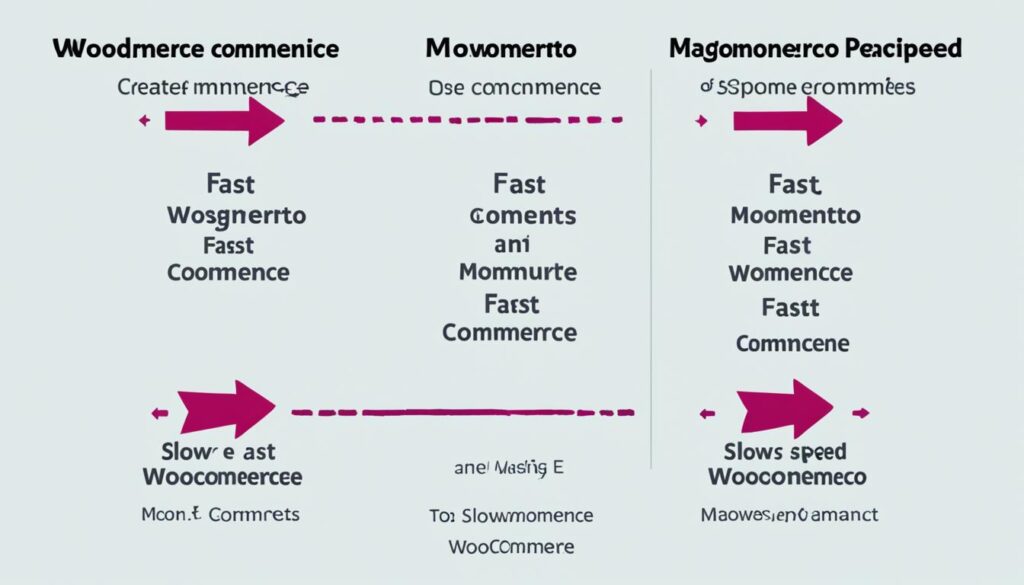Deciding on the right e-commerce platform for your online store can be a challenging task. With so many options available, it’s crucial to understand the differences between platforms to make an informed decision. In this article, we’ll compare two popular platforms – WooCommerce and Magento – and help you determine which one is better suited for your e-commerce needs.
When comparing WooCommerce vs Magento, there are several factors to consider, including pricing, features, and overall suitability for e-commerce. By the end of this article, you’ll have a clear understanding of the strengths and weaknesses of each platform, allowing you to choose the one that aligns best with your business goals.
So, let’s dive in and explore the differences between WooCommerce and Magento to find the perfect platform for your online shop.
What’s unique about WooCommerce vs Magento?
When it comes to e-commerce platforms, WooCommerce and Magento are two popular choices. Each platform has its own unique strengths and features that set it apart. Let’s take a closer look at what makes WooCommerce and Magento special.
WooCommerce: E-commerce Powerhouse for WordPress
WooCommerce is a powerful e-commerce plugin designed specifically for the WordPress platform. Built with simplicity and flexibility in mind, WooCommerce offers all the necessary features for running an online store seamlessly. Its integration with WordPress makes it a preferred choice for users who are already familiar with the WordPress ecosystem.
With WooCommerce, you can easily set up and manage your online store, even if you have limited technical knowledge. It provides a user-friendly interface and a wide range of customizable themes and plugins, allowing you to create a unique shopping experience for your customers.
One of the key advantages of WooCommerce is its extensive library of plugins and extensions. These plugins allow you to enhance your store’s functionality, from adding new payment gateways to implementing advanced inventory management systems.
Overall, WooCommerce offers a perfect balance between power and simplicity, making it an excellent choice for small to medium-sized online stores.
Magento: Tailored for Ambitious E-Commerce Goals
Magento, now known as Adobe Commerce, is a robust e-commerce platform designed for web development professionals and medium to large online stores. It offers advanced features and scalability, making it an ideal choice for ambitious e-commerce goals.
With Magento, you have complete control over every aspect of your online store. It provides extensive customization options, allowing you to create a visually stunning and highly functional store that meets your specific requirements. Whether it’s advanced product management, personalized customer experiences, or seamless third-party integrations, Magento has got you covered.
Magento’s strength lies in its ability to handle large amounts of data and complex store structures. It can efficiently manage catalogs with thousands of products and handle high levels of traffic without compromising performance.
Additionally, Magento offers a dedicated marketplace where you can find a wide range of extensions and themes to enhance your store’s capabilities further.
While Magento requires more technical expertise for setup and maintenance, its advanced features make it a powerful solution for businesses looking to scale and expand.
Choosing the Right Platform
Both WooCommerce and Magento offer unique advantages that cater to different needs and goals. When deciding between the two, it’s essential to consider the scale and complexity of your e-commerce venture.
If you are a small to medium-sized business or if you prefer a user-friendly interface with seamless integration into the WordPress platform, WooCommerce is an excellent choice. It provides a simplified setup process, extensive customization options, and a vast library of plugins to enhance your store’s functionality.
On the other hand, if you have ambitious growth plans and require advanced features and scalability, Magento is the way to go. It offers comprehensive customization options, robust performance, and seamless integration with third-party systems.
Ultimately, the right choice depends on your specific requirements and long-term goals. Evaluating the unique strengths of WooCommerce and Magento will help you make an informed decision to set up a successful online store that meets your needs.
| WooCommerce | Magento | |
|---|---|---|
| Platform Type | Plugin for WordPress | E-commerce platform for web development professionals |
| Scalability | Good for small to medium-sized online stores | Ideal for medium to large online stores with ambitious goals |
| Customization | Extensive customization options through WordPress themes and plugins | Advanced customization options for highly tailored stores |
| Features | All necessary features for running an online store | Extensive features for advanced product management and personalized customer experiences |
| Third-party Integrations | Wide range of plugins available for seamless integrations | Efficient APIs for integration with third-party systems |
| Performance | Dependent on web hosting and optimization measures | Handles large amounts of data and high traffic efficiently |
| Setup and Maintenance | User-friendly setup process | Requires more technical expertise for setup and maintenance |
| Pricing | Free, with additional costs for premium themes and plugins | Free open-source version available, with additional costs for premium services |
WooCommerce vs Magento: A look at their features
When comparing WooCommerce and Magento, it’s essential to consider their key features. Understanding what each platform offers will help you make an informed decision based on your specific needs and requirements.
WooCommerce
WooCommerce is a completely free platform that seamlessly integrates with WordPress, offering a user-friendly e-commerce solution. With WooCommerce, you have the freedom to create an online store that supports unlimited products. Utilizing WordPress themes, you can customize the look and feel of your store to match your brand and provide a unique experience for your customers. Additionally, WooCommerce has a vast selection of extensions available, allowing you to enhance your store’s functionality and meet your business goals.
Magento
Magento, now known as Adobe Commerce, offers a more robust solution primarily targeted towards professionals and medium to large-sized online stores. It provides a free open-source version as well as premium services to cater to different business requirements. With Magento, you can take advantage of its own theming and layout system, enabling you to create a visually stunning and personalized online store. The platform also supports a wide range of APIs, facilitating seamless integration with various third-party solutions. Moreover, Magento offers advanced security features to protect your business and customer data. In addition to its core features, Magento boasts a substantial extension marketplace, giving you access to thousands of extensions that can further enhance your store’s functionality and support your business objectives.
Comparing the features of WooCommerce and Magento is crucial in determining which platform aligns better with your specific needs. Whether you prioritize flexibility and ease of use or require advanced features and scalability, both platforms offer robust solutions for creating and managing your online store.
| Features | WooCommerce | Magento |
|---|---|---|
| Platform Cost | Free | Free open-source version and premium services |
| Support for Unlimited Products | ✓ | ✓ |
| Customization Options | Extensive customization through WordPress themes | Own theming and layout system |
| Extension Marketplace | Large variety available | Robust marketplace with thousands of options |
| API Support | – | Wide range of APIs for seamless integration |
| Advanced Security Features | – | Provided |
By exploring the features offered by both WooCommerce and Magento, you can make an informed decision and choose the platform that best suits your business needs, ensuring long-term success for your online store.

What each platform has to offer
When it comes to choosing between WooCommerce and Magento for your online store, it’s crucial to understand what each platform brings to the table. Let’s take a closer look at the offerings of both platforms to help you make an informed decision.
WooCommerce
WooCommerce is a popular choice among WordPress users, powering nearly 400,000 active sites. It stands out with its user-friendly experience and seamless integration with WordPress, making it an ideal solution for those familiar with the content management system.
Key features of WooCommerce include:
- Support for unlimited products: Whether you have a small or large inventory, WooCommerce has got you covered.
- Robust extension system: Take advantage of numerous plugins and extensions to enhance your store’s functionality and design.
- Wide range of payment processors: WooCommerce supports multiple payment gateways, giving your customers flexibility in choosing their preferred payment method.
Setting up a basic store with WooCommerce is free, but keep in mind that additional costs may arise from premium themes and extensions, depending on the level of customization you desire.
Magento
Magento, now known as Adobe Commerce, is designed for larger businesses and professionals looking for advanced e-commerce capabilities. It offers a range of features tailored to meet the needs of medium to large online stores.
Notable features of Magento include:
- Support for unlimited products: Whether you have a vast catalog or plan to expand in the future, Magento can handle any scale of inventory.
- Theming and layout system: Customize the look and feel of your store to align with your brand’s identity and create a unique shopping experience for your customers.
- Efficient APIs: Magento provides seamless integration with various third-party solutions through its extensive API support, allowing you to connect your store with other business systems.
Magento offers an open-source version that is free to use, but it also offers Pro and Managed Services versions with additional costs. These premium versions provide more advanced features and support for larger businesses.
By considering the offerings of each platform, you can determine which one best aligns with your specific needs and goals for your online store.

| Features | WooCommerce | Magento |
|---|---|---|
| Customization Options | Extensive customization options through WordPress themes | Own theming and layout system for advanced customization |
| Support for Unlimited Products | ✓ | ✓ |
| Extension Marketplace | Large variety of extensions available | Robust extension marketplace with thousands of options |
| Pricing | Setting up a store is free, additional costs for premium themes and extensions | Open-source version is free, Pro and Managed Services versions come with additional costs |
| Target Audience | WordPress users, smaller stores | Larger businesses and professionals |
What about performance, security, and product management?
When it comes to running an e-commerce store, performance, security, and product management play crucial roles in the success of your business. Let’s take a closer look at how WooCommerce and Magento compare in these aspects.
Performance and Speed
Both WooCommerce and Magento offer excellent performance, but it’s important to note that the speed and performance of your online store will depend on various factors. Your choice of web hosting and optimization measures can significantly impact the loading times of your site.
WooCommerce, as a WordPress plugin, benefits from the optimized infrastructure of WordPress. With proper hosting and caching, WooCommerce can offer fast-loading pages that provide a seamless shopping experience for your customers.
Magento, on the other hand, is specifically tailored for medium to large online stores. Its architecture and advanced features make it a robust platform that can handle high traffic and complex e-commerce operations. However, Magento may require more server resources and advanced optimization techniques to ensure optimal performance.
Ultimately, the performance of your online store will depend on the specific configuration and optimization efforts you put into your chosen platform.
Security Features
Security is always a top concern when it comes to e-commerce. Both WooCommerce and Magento offer advanced security features, ensuring the safety of your customers’ data and transactions.
WooCommerce provides a solid foundation for security, leveraging the security measures of WordPress. It includes features such as SSL encryption, secure payment gateways, and comprehensive user roles and permissions.
Magento, on the other hand, is known for its robust security. It takes the lead with dedicated security patches and regular updates to protect your store from vulnerabilities. However, implementing these patches may require web development knowledge or professional assistance.
In terms of security, both platforms are reliable choices, but Magento’s dedicated focus on security gives it an edge for stores that prioritize top-notch protection.
Product Management
Efficient product management is essential for any online store. WooCommerce and Magento offer different approaches to product management, catering to different needs and levels of complexity.
WooCommerce excels in user-friendliness, providing an intuitive interface for managing products. It offers options for both physical and digital products, allowing you to easily add, edit, and organize your inventory. With WooCommerce, you can set up product variations, manage stock levels, and apply product tags and categories.
Magento, on the other hand, provides a wide range of advanced features for product customization and management. It offers powerful tools for managing complex product catalogs, including options for configurable products, bundled products, and group products. With Magento, you have more flexibility in customizing product attributes, pricing, and options.
For small to medium-sized stores with straightforward product management needs, WooCommerce’s user-friendly approach may be a better fit. However, if you have a large inventory or require advanced product management capabilities, Magento’s feature-rich platform could be the right choice.

Considering the performance, security, and product management aspects of each platform is crucial in determining which one is best suited for your e-commerce business. Now that we’ve covered these key factors, let’s move on to the final section of our comparison.
Conclusion
In conclusion, when it comes to choosing between WooCommerce and Magento for your e-commerce store, it’s essential to consider your specific needs and goals.
For users familiar with WordPress, WooCommerce offers a user-friendly experience and extensive customization options. It seamlessly integrates with the popular content management system, allowing you to leverage its features and plugins. With WooCommerce, you can easily set up and manage your online store while maintaining the familiarity of WordPress.
On the other hand, Magento is an ideal choice for larger businesses with ambitious e-commerce plans. It provides advanced features and scalability, making it suitable for high-volume stores. Magento is known for its robustness and offers a wide range of functionalities to meet the demands of complex online businesses.
Consider factors such as pricing, features, performance, security, and product management when making your decision. Both platforms have their strengths and cater to different types of businesses. By carefully evaluating your specific requirements, you’ll be able to choose the best platform for your e-commerce venture.
FAQ
What are the key differences between WooCommerce and Magento?
WooCommerce is a plugin for WordPress, offering a user-friendly experience and extensive customization options. Magento, on the other hand, is specifically designed for professionals and larger online stores, providing advanced features and scalability.
Is WooCommerce free to use?
Yes, WooCommerce is a free platform. However, additional costs may arise from premium themes and extensions.
Does Magento offer a free version?
Yes, Magento offers a free open-source version. However, there are also premium services available with additional costs.
Which platform is more suitable for WordPress users?
WooCommerce is the ideal choice for WordPress users, as it seamlessly integrates with the platform and maintains its user-friendly experience.
Can Magento support unlimited products?
Yes, both WooCommerce and Magento support unlimited products.
Which platform offers a larger variety of themes and extensions?
WooCommerce offers a large variety of themes and extensions through the WordPress ecosystem. Magento has its own theming and layout system and a robust extension marketplace with thousands of options.
What are the security features of WooCommerce and Magento?
Both platforms offer advanced security features. However, Magento takes the lead with dedicated security patches. Implementing these patches may require web development knowledge or professional assistance.
Are there any additional costs for using WooCommerce or Magento?
While setting up a store with WooCommerce is free, additional costs may arise from premium themes and extensions. For Magento, the open-source version is free, but the Pro and Managed Services versions come with additional costs.
Which platform is more suitable for larger businesses?
Magento, with its advanced features and scalability, is more suitable for larger businesses with ambitious e-commerce plans.
What factors should I consider when choosing between WooCommerce and Magento?
Factors such as pricing, features, performance, security, and product management should be considered when making a decision between WooCommerce and Magento.
